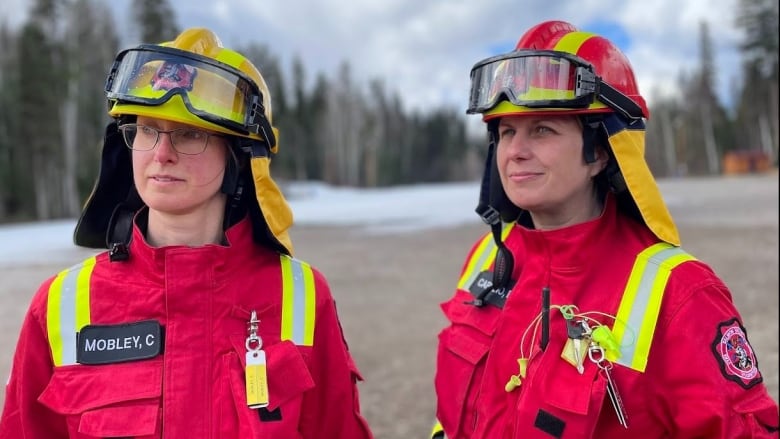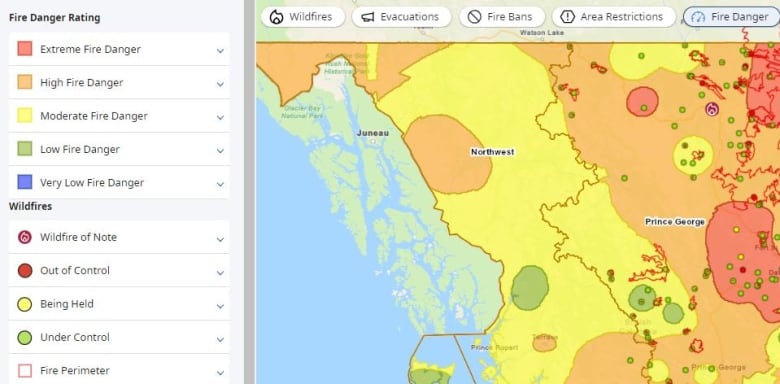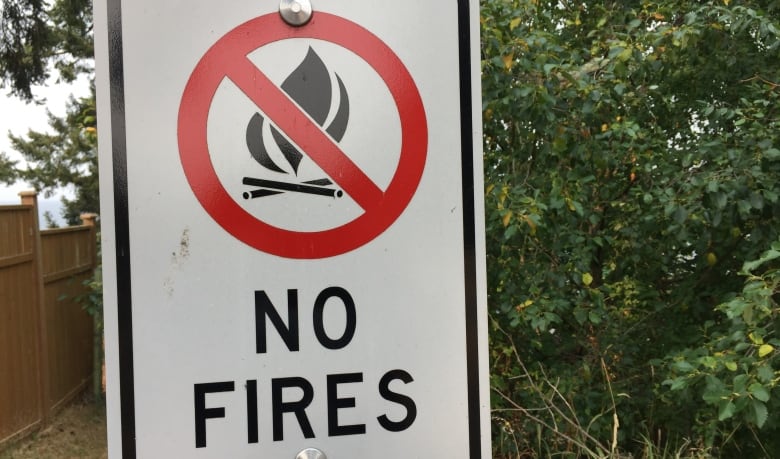Your guide to B.C. wildfires: Maps, evacuation orders, air quality and more
Here's a list of resources on preparing for the threat of wildfires and what to do if you're affected

Poor internet connection?Access a low-bandwidth, accessible version of this story on CBC Lite.
UPDATE May 17, 2024:Wildfire has forcedthe evacuation of Fort Nelson and the Fort Nelson First Nation. A separate fire has prompted the evacuation of the Doig River First Nation and a portion of the Peace River Regional District near Fort St. John.
Updates for residents of the Fort Nelson regionare being posted on the Northern Rockies Regional Municipality's website, as well as thethe municipalFacebook pageand theFort Nelson First Nation Facebook page.
For Doig River, it is the Doig River First Nation Facebook pageand Peace River Regional District website.
Evacuees seeking help, including for meal and shelter vouchers, shouldregister online at ess.gov.bc.ca or at the following emergency reception centres:
- Fort St. John:North Peace Arena (9805-96 Ave.) Evacuees without accommodation in Fort St. Johnare being asked to travel to another community, if they are able.
- Sunset Prairie: The province has set up single dorm-style rooms (no pets or alcohol)with private bedrooms and support staff atSunset Prairie Industry Camp (4591 Braden Road).
- Dawson Creek:Sudeten Hall, Walter Wright Pioneer Village (1901 Alaska Hwy.)
- Chetwynd:City Hall (5400 Hospital Rd.)
- Prince George: Exhibition Grounds near the CN Centre(41 Keller St.)
Prince George has set up a permanent emergency reception centre at the latterlocation to serve as the base for the city's summer emergency response.
Evacuees who need help seeking support can contact Service B.C. at 1-800-387-4258 or the Fort St. John emergency reception centre at250-794-3310.
A mental health support line for evacuees isavailable at 310-6789 (no area code).
The Northern Rockies Regional Municipality has also set up a frequently asked questions page for evacuees.
The B.C. Wildfire Service posts is posting updates on the fires near Fort Nelson regularly, with the first update of the day coming at about 10 a.m. PT and the last around10 p.m. PT. Those fires include:
In the Doig River area:
For more news updates,findthe latest wildfire news and stories from CBC British Columbia.
A lower-than-average snowpack combined with ongoing drought through much of British Columbiahas officials bracing for what is likely to be another challenging year for wildfires.
The wildfire seasonof 2023 was unprecedented, with thousands of people forced from their homes and more than 28,419 square kilometres of land burned close to the area of Vancouver Island.
The season in 2024 started early, first with holdover or "zombie" fires smoking in early Februarythen with the first evacuation alerts being issued on April 21.
The following is a list of resources available to helpget prepared for wildfires in advance, as well as how to find up-to-date local information on evacuation orders and alerts, road closures and air quality advisories as the season develops.
Tracking wildfires in your region
The B.C. Wildfire Service (BCWS)provides alist of all current wildfiresin the province, as well asan interactive mapthat allows you to see where the fires are burning relative to specific communities.
Particular attention is paid towildfires of note, which are"highly visible" or pose "a potential threat to public safety."

Wildfires may also be classified asout of control,which means crews are not able to curb their spread. These fires may not necessarily pose a threat to public safety if they are far fromhomes or property.
Regular updates are posted by the service onFacebook, Xand YouTubeand it also offers an app on the Apple App Store and Google Play.
Understanding wildfire terminology
In addition towildfires of noteandout of control wildfires, here are some other key terms you may hear:
Awildfireis an unplanned fire that occurs in a wilderness area, away from people or structures.
A prescribed burn that escapes its intended perimeter can also be considered a wildfire.
Aninterface firecould potentially affect man-made structures, while at the same time burning natural fuels such as trees and shrubs. In this situation, a house fire could jump to the forest or vice versa.
When afire is under control but still smouldering it isbeing held.
A fire is consideredcontainedwhen afuel-free perimeterhas been established around the blaze.
You can find afull glossaryof terms on the BCWS website.
Evacuation orders and alerts
Local governments and First Nations are responsible for issuing evacuation orders and alerts during emergencies.
Anevacuation alertmeans you should be prepared to leave your property at a moment's notice.
Anevacuationordermeans you must leave the area immediately and are not allowed inside the area covered by the order. These are often enforced by police.
Many local governments have set up text alert systems, which youcan sign up forby visiting yourmunicipal government website.
Regional districts often take the lead when it comes to emergency situations. CivicInfo B.C.maintainsadirectory of regional districts.
After a local government issues an evacuation order or alert, the information is posted online byEmergency Info B.C.
Everyone affected by an evacuation order is asked to check in at a reception centre or via phone so officials can be sure they are safe.
Causes: lightningvs. human activity
The causes of wildfires in B.C. are divided into two broad categories: lightning andhuman activity. The BCWS says, on average, 60 per cent of all wildfiresin the province are caused by lightning.
Human-caused wildfires are all fires that are not the result of lightning. This can include fires set deliberately or by accident, including through campfires, sparks from railways or industrial activity, discarded cigarettes, fireworks, or lanterns.
The BCWS and other law enforcement agencies may all be involved in investigating human-caused wildfires, and investigations can take months to complete.
Burn bans and restrictions
The B.C. governmentprovides a list ofall fire bans and restrictions.
Not all burn bans include a ban on campfires: Open burning bans may restrict the use of burn barrels or fireworks, for example, while still allowing for smaller controlled campfires.
You can learn more about the different categories of burn bans on the B.C. government's open burning page.

To report a wildfire, unattended campfire or open burning violation, you can call toll-free1-800-663-5555 toll-free or *5555 on a cellphone.
Protectyour home through FireSmart B.C.
FireSmart B.C. is a program aimed at preventing wildfires with tools aimed at First Nations, local government and fire departments.
It offers a series of guides for individuals on how to manage the landscape around homes and properties to decrease the risk of wildfires causing damage, including landscaping guidesand tips on maintaining your home to be as fire-resistant as possible.
Beprepared to evacuate
Officials recommend you prepare a grab-bag of key items, such as identification, medication and cellphones,so you are ready to leave at a moment's notice.
If your home is under an evacuation alert, it is recommended you bring your kit with you when you run errands or go to work, in case evacuation orders are issued while you're out and you're unable to return home.
Prepared B.C. has asuggested packing list on its website,as does thefederal government.


Road closures
You can check road conditions, closures, delays and detours by visiting theDriveBCwebsite, maintained by the province's transportation ministry.
If you do not have internet access, you can call 1-800-550-4997toll free to find out current conditions.
Accessing shelter and support
If you are affected by an emergency situation, supports arein placeso you can have a place to sleep, access food vouchers and receive financial aid.
This information is collected on the B.C. government'semergency management website.
Insurance
The Insurance Bureau of Canada (IBC)says all standard homeowner and tenant insurance policiescover damage caused by firesand also providecoverage to help with the cost of mass evacuations.
It has put together a help page with information for evacuees hoping to file a claim.
IBC advises anyone forced to fleeto make a list of damaged or destroyed items and keep receipts for expenses they incur. The more details, it says, the better when it comes to making a claim.
The bureau also recommends getting your insurance claim started as soon as possible.
Helping others
The BCWSsaysit cannot accept donationsof food, suppliesor equipment, nor can individual members.
Instead, it suggests those wishing to help work with organizations like the Canadian Red Cross, which has launched an appeal to help support people affected by wildfires.
The Red Cross says financial donations are the best way to help, so resources can be directed where they are needed and not go to waste.
Canadians wishing to make a donation can do so online atredcross.caor by calling 1-800-418-1111.
You can check for verified charities through CanadaHelps.
Air quality
Even if flames aren't an imminent threat, smoke from wildfires can travel hundreds of kilometresand affect people's health.
B.C.'s Ministry of Environment issues air quality advisories and smoky skies bulletins on its website, which are also distributed as public weather alertsby Environment Canada and through social media channels.
The B.C. governmentprovides anair quality health indexandmapthat use data frommonitoringstations across the province.
You can also sign up for air quality advisories and smoky skies bulletins for your region through email or text message on the province'sB.C. Air Quality website.
Additionally, researchers at the University of Northern British Columbia have partnered with Environment and Climate Change Canada tocreate a crowdsourced mapusing air quality monitors from across the country.
Learn more about the latest wildfire science and how B.C. is preparing for the 2024 wildfire season:
With files from The Canadian Press



.png)













_(720p).jpg)


 OFFICIAL HD MUSIC VIDEO.jpg)
.jpg)








































































































